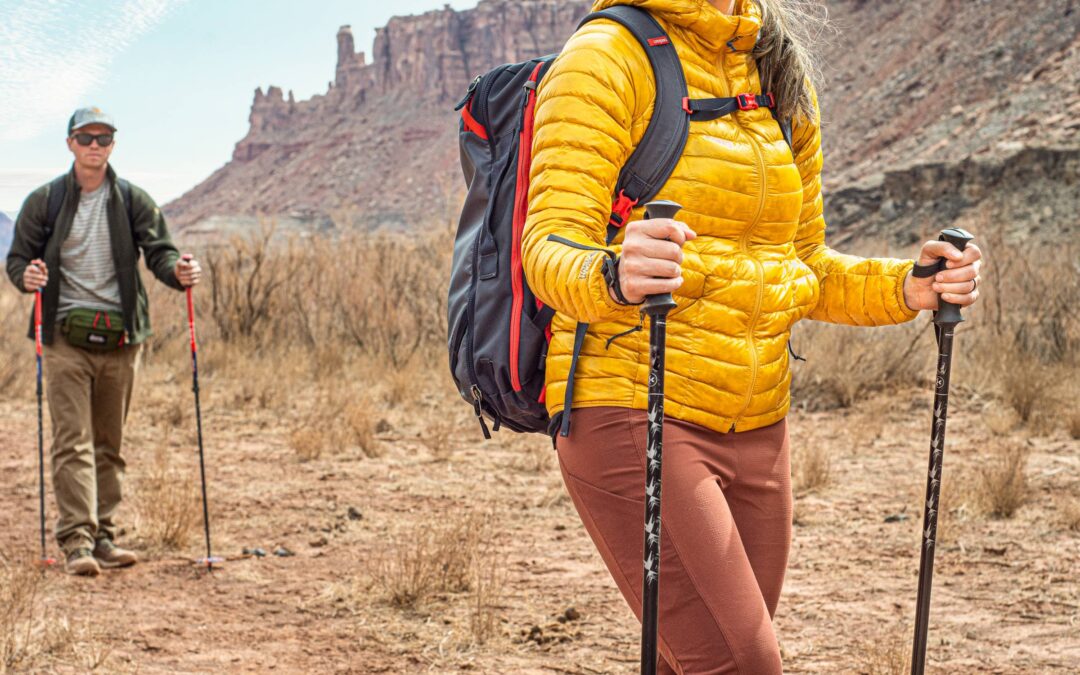It is a rather common misconception that the use of trekking poles is only for older adults and those with debilitating joint issues. But those who are avid hikers or those who are training for long-distance hiking know there are many advantages to having these in your gear pack.
Trekking poles are great for all hikers who want to:
- Protect their knees when downhill hiking.
- Prolong the onset of leg fatigue by distributing weight between arms & legs.
- Use as a makeshift splint in the event of an injury.
- Increase speed by creating a rhythm.
- Increase balance on uneven terrain, river crossings, and slippery log crossings.
- Test unstable terrain before stepping on it.
- Push problematic things like poison oak, spiderwebs, & thorns out of the way.
- Check the depth of a puddle or snow bridge.
- Protect themselves against wildlife by lifting them overhead to appear larger to a threatening encounter.
Trekking poles are lightweight and serve multiple purposes. If someone is planning on bugging out, trekking poles would be a worthwhile addition to the emergency pack and will not take up much space. But as with most gear, there are pros and there are cons.
According to Clever Hiker, these are a few of the cons associated with using trekking poles:
Trekking poles can be cumbersome – For us, the biggest drawback to trekking poles is that they can be limiting in some situations. On trails where you need to do hand-over-hand climbing or you have to use rope assists, it can be annoying to have to stash your trek poles on your pack, and then get them back out, and then stash them, and then get them back out. Likewise, if you like to take a lot of photos as we do, trekking poles tie up your hands and can get in the way when you need to grab a quick shot.
Weight – Some people like to use their poles only on uphill and downhill stretches of trail. This means that the poles are stashed on their packs in the meantime, which of course is extra carried weight.
You may be using more energy – It’s generally accepted that pumping your arms with trekking poles expends more energy than walking without poles. There haven’t been many studies on this and some people disagree. Our feeling is that a little extra workout for our arms isn’t necessarily a bad thing, and if the stress-reducing benefits of trekking poles are a good fit for you, then the extra expended energy is likely totally worth it.
Expensive – Putting together a good hiking/backpacking kit can be pretty expensive. Trekking poles are not a necessary piece of gear, so the cost can be hard to justify for those starting from scratch with little to no gear or for hikers on a budget. Our favorite trekking poles range in price from around $60 all the way up to $200. If you are looking for a solid pair of affordable poles, we recommend the Montem Ultra Strong Trekking Poles.
Not always LNT friendly – The carbide tips on many trekking poles dig into rock, which will often leave unsightly scratches, gouges, and chips in rock formations on the trail. This can be off-putting to some, especially when traveling over old and pretty granite formations.
Some people may benefit from the use of trekking poles, while others may opt to forego them altogether. Ultimately, the choice is yours, but make sure you understand to benefits and possible pitfalls of using them. Either way, make the decision that’s right for you!
This article was originally published at Ready Nutrition™ on May 20th, 2022







